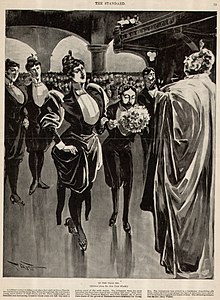
Back منحدر زلق Arabic Yamac prosesləri Azerbaijani Teoria del pendent relliscós Catalan Argument šikmou plochou Czech Dammbruchargument German Pendiente resbaladiza Spanish شیب لغزنده Persian Kaltevan pinnan argumentti Finnish Pente savonneuse French מדרון חלקלק HE

In a slippery slope argument, a course of action is rejected because the slippery slope advocate believes it will lead to a chain reaction resulting in an undesirable end or ends.[1] The core of the slippery slope argument is that a specific decision under debate is likely to result in unintended consequences. The strength of such an argument depends on whether the small step really is likely to lead to the effect. This is quantified in terms of what is known as the warrant (in this case, a demonstration of the process that leads to the significant effect).
This type of argument is sometimes used as a form of fearmongering in which the probable consequences of a given action are exaggerated in an attempt to scare the audience. When the initial step is not demonstrably likely to result in the claimed effects, this is called the slippery slope fallacy. This is a type of informal fallacy, and is a subset of continuum fallacy, in that it ignores the possibility of middle ground and assumes a discrete transition from category A to category B. Other idioms for the slippery slope fallacy are the thin edge of the wedge, domino fallacy (as a form of domino effect argument) or dam burst, and various other terms that are sometimes considered distinct argument types or reasoning flaws, such as the camel's nose in the tent, parade of horribles, boiling frog, and snowball effect.
- ^ "Slippery Slope". TXSt.edu. Department of Philosophy, Texas State University. 11 January 2016. Retrieved 16 December 2023.
© MMXXIII Rich X Search. We shall prevail. All rights reserved. Rich X Search